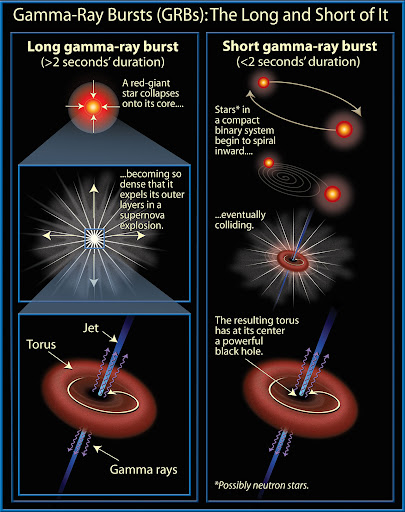GRB 200826A: Gamma-Ray Burst | 28 Jul 2021
Why in News
Recently, a group of astronomers have detected a very short, powerful burst of high-energy radiation also known as Gamma-Ray Bursts (GRBs) that lasted for about a second.
- It was named GRB 200826A after the date it occurred, which is 26th August 2020.
- It was detected by National Aeronautics and Space Administration’s (NASA’s) Fermi Gamma-ray Space Telescope.
Key Points
- Gamma-Ray Bursts:
- About:
- They are the most powerful events in the universe, detectable across billions of light-years.
- A light-year is the distance a beam of light travels in a single Earth year, or 9.5 trillion kilometers.
- Astronomers classify them as long or short based on whether the event lasts for more or less than two seconds.
- They are the most powerful events in the universe, detectable across billions of light-years.
- Long GRBs:

- They observe long bursts in association with the demise of massive stars.
- When a star much more massive than the Sun runs out of fuel, its core suddenly collapses and forms a black hole.
- Black hole refers to a point in space where matter is so compressed as to create a gravity field from which even light cannot escape.
- As matter swirls toward the black hole, some of it escapes in the form of two powerful jets that rush outward at almost the speed of light in opposite directions.
- Astronomers only detect a GRB when one of these jets happens to point almost directly toward Earth.
- Each jet drills through the star, producing a pulse of gamma rays – the highest-energy form of light – that can last up to minutes.
- Following the burst, the disrupted star then rapidly expands as a supernova.
- A supernova is the name given to an exploding star that has reached the end of its life.
- Short GRB:
- Short GRB, on the other hand, forms when pairs of compact objects – such as neutron stars, which also form during stellar collapse – spiral inward over billions of years and collide.
- A Neutron star comprises one of the possible evolutionary end-points of high mass stars.
- Short GRB, on the other hand, forms when pairs of compact objects – such as neutron stars, which also form during stellar collapse – spiral inward over billions of years and collide.
- About:
- GRB 200826A:
- It was a sharp blast of high-energy emission lasting just 0.65 seconds.
- After traveling for a very long period of time through the expanding universe, the signal had stretched out to about one-second-long when it was detected by Fermi’s Gamma-ray Burst Monitor.
- It had been racing toward Earth for nearly half the present age of the universe.
- It is considered to be the the shortest GRB till now and it occurred caused by the death of a massive star.
- It was a sharp blast of high-energy emission lasting just 0.65 seconds.
- Significance of GRB 200826A:
- It has helped to resolve the long-standing issues related to gamma-ray bursts. Also, this study triggers to re-analyse all such known events to constrain number densities better.
- Researchers:
- The group included Indian astronomers from Aryabhatta Research Institute of Observational Sciences (ARIES), The Inter-University Centre for Astronomy and Astrophysics, Pune (IUCAA), National Centre for Radio Astrophysics - Tata Institute of Fundamental Research, Pune (NCRA) and IIT Mumbai.
- Fermi Gamma-ray Space Telescope:
- About:
- Formerly called the Gamma-ray Large Area Space Telescope (GLAST), it is a space observatory being used to perform gamma-ray astronomy observations from low Earth orbit.
- It was launched in June 2008. It is named after Enrico Fermi, an Italian-American scientist who did pioneering work in high-energy physics.
- Collaboration:
- Fermi is an astrophysics and particle physics partnership, developed in collaboration with the US Department of Energy, along with important contributions from academic institutions and partners in France, Germany, Italy, Japan, Sweden, and the U.S.
- Major Function:
- It maps the entire sky every three hours. It provides an important window into the most extreme phenomena of the universe, like GRBs, black-hole jets, and pulsars.
- Pulsars are types of neutron stars which emit radio pulses at regular intervals.
- It maps the entire sky every three hours. It provides an important window into the most extreme phenomena of the universe, like GRBs, black-hole jets, and pulsars.
- About:
Gamma Rays
- About:
- They are the highest-energy light in the universe. They can have over a billion times the energy of the type of light visible to our eyes.
- They are produced by the hottest and most energetic objects in the universe, such as neutron stars and pulsars, supernova explosions, and regions around black holes.
- The gamma rays possess high energy; they can pass right through any lens or mirror, making it very difficult to focus them in a visible-light telescope.
- Gamma-Rays on Earth:
- On Earth, gamma rays are generated by nuclear explosions, lightning, and the less dramatic activity of radioactive decay.
- Gamma-ray astronomy is the astronomical observation of gamma rays with photon energies above 100 keV (Kilo Electron Volt).
- Gamma rays are so energetic that they are harmful to life on Earth.
- Earth's atmosphere absorbs gamma rays, preventing them from affecting life on the ground.
- Astronomical observations of gamma-ray sources are therefore done with high-altitude balloons or satellites, above the protective blanket of Earth's atmosphere.
